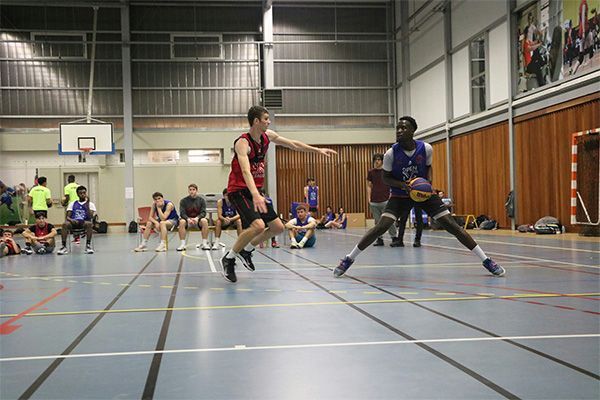
By: Becky Meline, LIMHP MGCP
The truth is: self-doubt is normal. What matters most is how you respond to it. Building the right mindset and tools can help you move through those doubts and refocus on what you can control.
Here are some practical strategies for athletes to handle self-doubt and step confidently into their role on the team:
1. Shift Your Focus from Comparison to Growth
It’s easy to compare yourself to teammates or opponents, but comparison often fuels insecurity. Instead, track your own growth.
- Ask yourself: “Am I improving from last week? Last season?”
- Keep a training journal where you write down small wins.
- Focusing on personal progress helps you recognize that you belong because you’re committed to growth, not because you’re perfect.
2. Reframe the “Am I Good Enough?” Question
Instead of asking “Am I good enough?” try asking:
- “What can I do today to get 1% better?”
- “How can I help my team right now?”
This shift turns self-doubt into action. It keeps you grounded in effort and learning, not in judgment.
3. Use Positive Self-Talk
What you say to yourself matters. Doubt often comes with a harsh inner voice. Challenge that voice by creating a short, empowering phrase you can repeat during tough moments, such as:
- “I’ve trained for this.”
- “I bring value to this team.”
- “One play doesn’t define me.”
Athletes who consistently practice positive self-talk train their minds just like they train their bodies.
4. Lean Into the Team Mindset
Remember—you’re not on your team by accident. Coaches chose you for a reason. Instead of focusing on where you rank compared to others, think about what you add: hustle, energy, encouragement, a specific skill set.
Belonging isn’t about being perfect; it’s about contributing to the bigger picture.
5. Normalize Mistakes
Self-doubt often spikes after a missed shot, an error, or a bad game. But mistakes are part of being an athlete. Use them as fuel to learn instead of proof that you don’t belong. A powerful reframe:
- “Mistakes mean I’m pushing my limits.”
- “Every athlete—even the best—has bad games.
6. Develop a Pre-Performance Routine
Having a routine before practice or competition can anchor you when doubts rise. This could include deep breathing, listening to music, visualizing your role, or using your positive affirmation. A consistent routine tells your body and mind: “I’m ready.”
7. Talk About It
Many athletes think they’re the only ones struggling with self-doubt, but that’s rarely true. Opening up to a coach, teammate, or sports counselor can help you realize you’re not alone. Sometimes, simply naming your doubt makes it lose its power.
Final Takeaway
Self-doubt doesn’t mean you don’t belong—it means you care. The question isn’t whether you’re “good enough.” The real question is: Are you willing to keep showing up, learning, and growing?
The answer to that is already yes.
Becky Meline, LIMHP MGCP
Licensed Clinician & Certified Performance Coach
Focus Therapy & Performance Coaching
402.513.4416

Becky Meline, LIMHP MGCP Comparison is something every athlete faces — whether it’s comparing stats, playing time, body type, or social media highlights. In today’s world, athletes aren’t just competing on the field or court — they’re competing with what they see online. You scroll through Instagram and see a teammate posting highlight reels, another athlete committing to their dream school, or someone showing off their “perfect” body or training grind. Before you know it, you start questioning your own progress and wondering if you’re enough. Here’s the truth: comparison steals joy, confidence, and focus — three things every athlete needs to perform at their best. Let’s talk about how to manage it. 1. Recognize That You’re Seeing a Highlight Reel Social media shows the best moments, not the full story. That picture-perfect post doesn’t show the athlete’s struggles, failures, or late-night frustrations. Remind yourself that you’re seeing a filtered version of someone’s journey — not their full reality. When you catch yourself comparing, try saying to yourself: “I’m only seeing their highlight reel, not their hard days.” Grounding yourself in that truth helps bring the focus back to your own path. 2. Focus on Your Lane Every athlete develops differently — physically, mentally, and emotionally. Some teammates peak early, others find their stride later. Comparing your chapter 2 to someone else’s chapter 10 only hurts your growth. Instead, shift your mindset: Set your own goals — what do you want to improve this week? Track your own progress — celebrate small wins like better recovery, stronger mindset, or consistent effort. Remember your why — why you play, why you train, and what you love about your sport. When your focus is inward, comparison loses power. 3. Use Comparison as Feedback, Not Judgment Comparison isn’t always bad — it can become fuel when used the right way. Instead of thinking, “She’s so much better than me,” shift to, “What can I learn from her?” If a teammate has great confidence, work on your mental game. If someone’s faster or stronger, ask what drills or training helped them. Growth-minded athletes turn comparison into curiosity — not criticism. 4. Take Breaks from Social Media If scrolling makes you feel less than, it’s okay to step back. Unfollow accounts that trigger insecurity and follow people or pages that inspire healthy habits, positivity, and confidence. Try creating boundaries: No scrolling before or after practice 24-hour social media break after tough games Limit time on comparison-heavy platforms like Instagram or TikTok Protect your mental space the same way you protect your body — both impact performance. 5. Build Genuine Connections with Teammates Comparison can isolate you — but connection heals it. When you build real relationships with teammates, you realize that everyone has insecurities and goals they’re working toward. Support each other. Celebrate each other’s wins. When your team culture is rooted in encouragement instead of comparison, everyone performs better. 6. Remind Yourself of What Makes You, You No one else has your exact mindset, skills, story, or purpose. That’s your superpower. When you catch yourself comparing, pause and remind yourself: “I have my own strengths, and I’m working on becoming my best self.” Confidence grows when you anchor your worth in who you are — not in how you measure up to others. Every athlete struggles with comparison — it’s part of being human. But learning to manage it is part of becoming mentally strong. Focus on your growth, surround yourself with supportive people, and remember that your path doesn’t have to look like anyone else’s to be meaningful. You’re building your story — and that’s something worth being proud of. Becky Meline, LIMHP MGCP Licensed Clinician & Certified Performance Coach

Becky Meline, LIMHP MGCP Every athlete wants to succeed—or at least feel that they have reached their highest potential. You train hard, set goals, and push yourself to reach your potential. But sometimes, that drive for success turns into something heavier — the pressure to be perfect. When every mistake feels like failure, confidence and joy in the sport can quickly fade. Perfectionism in sports is one of the main culprits that bring athletes into my office. That’s where mindset comes in. Understanding whether you’re operating from a growth mindset or a fixed mindset can completely change how you handle mistakes, challenges, and even perfectionism itself. What’s the Difference? Fixed Mindset: A fixed mindset believes that your abilities and talents are set in stone — you’re either “good” or “not good” at something. Athletes with this mindset might think, “I’m just not fast enough,” or “If I mess up, it means I’m not talented.” Mistakes become threats. Feedback feels personal. Failure means you’re “not enough.” Growth Mindset: A growth mindset sees abilities as things that can be developed through effort, practice, and learning. Challenges become opportunities to grow. Mistakes are feedback. And setbacks are simply part of the process of getting better. This mindset says, “I can learn from this,” or “I haven’t mastered it yet. How Mindset Affects Perfectionism Perfectionism often grows out of fear — fear of not being good enough, of disappointing others, or of making mistakes. When you have a fixed mindset, that fear feels justified because every error feels like proof that you’ve hit your limit. But when you shift to a growth mindset, mistakes stop being proof of weakness. Instead, they’re part of your path to mastery. You begin to understand that everybody starts as a beginner until they meet mastery in a skill. Failure doesn’t define you. Effort isn’t a sign of lack — it’s the key to improvement. Progress matters more than perfection Practical Ways to Build a Growth Mindset 1. First and foremost, you have to believe it’s possible for you to improve and get better. It might sound simple, but it’s the first step to becoming your greatest self. When athletes don’t believe it’s possible, it’s the exact opposite of a growth mindset and it keeps you stuck. 2. Add “Yet” to Your Thinking When you catch yourself saying, “I’m not good at this,” add “yet.” → “I’m not good at this yet.” It’s a small word that shifts your thinking from limitation to possibility. “Yet” helps you see that this is a skill that can be developed and improved upon through effort and reps. 3. Mistakes are Data—use the information to help you grow After a tough game or practice, ask yourself: What did I learn? What will I do differently next time? What went well despite the mistake? 4. Focus on the Process, Not the Outcome Instead of obsessing over stats, rankings, or wins, focus on controllables — your effort, your attitude, your preparation. The more you value growth over results, the less perfection will control you. 5. Embrace Feedback as a Tool to Help you Grow—Not a Personal Attack Coaches correct you because they see potential. Listen to feedback without taking it as criticism of who you are — it’s simply a roadmap to improvement. 6. Celebrate Small Wins Every bit of progress deserves recognition. Whether it’s better body language, improved focus, or a new personal best, celebrating small wins reinforces growth over perfection. The most successful athletes aren’t the ones who never fail — in fact, they have likely failed more than anyone else. The difference is that they didn’t stop, they kept going and showed grit through their adversity. They’re the ones who learn, adapt, and keep going. A growth mindset frees you from the pressure of perfection and helps you rediscover the love of competing and improving. You don’t need to be perfect. You just need to keep growing—and keep in mind that everyone grows at different rates.

Becky Meline, LIMHP MGCP For many athletes, the dream of playing at the next level is both exciting and overwhelming. Junior year is a huge year both academically and athletically if you have a child interested in playing at the next level. The college recruitment process is filled with opportunities, but it also brings its fair share of stress, distractions, and comparison. To help you navigate this journey with confidence, here’s a roadmap that balances the practical side of recruiting with the mental and emotional skills needed to thrive. Know Your Path and Set Goals The first step in the recruitment journey is clarity. I tell my athletes that this is the “information gathering stage”--- Ask yourself: What level of college athletics am I realistically aiming for (Division I, II, III, NAIA, JUCO)? What type of school environment do I want academically and socially? How far from home am I comfortable going? Do they have the major that I am interested in studying? How much does it cost to go there in case I don’t get a full ride? Setting goals not only gives you direction but also helps you avoid distractions. When you know what you’re aiming for, it’s easier to tune out noise and comparison. This starts to give you a direction when you feel overwhelmed with where to start. Market Yourself Effectively College coaches don’t just “find” athletes anymore—you need to put yourself out there. Here’s how: Highlight videos: Create a short, clear highlight reel showcasing your best plays and skills. Keep it professional and concise. Player profile: Prepare an athletic résumé that includes stats, GPA, academic honors, contact info, and coach references. Social media presence: Keep your accounts clean, professional, and reflective of your character. Coaches notice how you present yourself online. Remember: marketing yourself is about showing your strengths, but also about being authentic. Coaches want athletes who fit their culture, not just highlight reels. Master the Conversation with Coaches Talking with college coaches can feel intimidating, but preparation helps. This is one of the biggest stressors for my athletes--knowing how to present themselves and what to say. Be respectful and direct: Always address coaches properly, thank them for their time, and be clear in your communication. Ask good questions: Inquire about team culture, academic expectations, and how they see you fitting into their program. I encourage my athletes to look into the program before you have a phone call so that it shows your level of interest in the school. Follow through: If a coach asks for film, transcripts, or updates, send them promptly. Reliability speaks volumes. Confidence comes from preparation. Practice with your high school or club coach, or even role-play conversations with a parent, so you’re ready when opportunities come. Handle the Mental Side of Recruiting The recruiting process can easily weigh on your mental health if you don’t protect yourself. Here are some common challenges—and strategies to handle them: Social Media Comparison It’s easy to scroll and see other athletes posting their commitments or offers and wonder, Why not me? Remember: everyone’s journey looks different. Instead of comparing, focus on your growth and opportunities. Celebrate others, but stay committed to your own path. Balancing Recruiting and Your Season Recruiting can feel like a full-time job. But your number one priority should always be your high school or club season—keep in mind that is where you are getting the highlight reels to send out! Coaches want to see you competing at your best, not burned out by the pressure of emails and highlight videos. I encourage my athletes to set aside designated times each week to handle recruiting tasks so it doesn’t take over your life. Whether that’s an open period you have each week or Sunday afternoons for a couple of hours—compartmentalize your time because you can only put your energy into one thing at a time. I tell my athletes that “no matter how well you worry about recruiting during school, practice or games, it is just wasted energy in that moment” so save it for your designated time. Managing Stress and Distractions Recruiting brings highs and lows—some coaches may show interest, others may not—and that doesn’t mean you’re not good enough. It’s important to stay grounded: Practice mindfulness or breathing exercises before games. Lean on trusted adults for perspective. Keep a journal of small wins to remind yourself of progress. Remember the Bigger Picture At the end of the day, recruitment isn’t just about where you play or what Division you’re in—it’s about where you’ll grow. The right program is one where you’ll thrive athletically, academically, socially and personally. Stay patient, keep working, and trust that the right fit will come. Final Thoughts The college recruitment journey is as much about mental resilience as it is about athletic talent. With a clear roadmap—setting goals, marketing yourself, preparing for coach conversations, and protecting your mindset—you can move through the process with confidence. Focus on what you can control, enjoy the ride, and remember: your worth isn’t defined by an offer, but by the effort, character, and dedication you bring every single day.

By: Stef McAlpin LMHP Parent-Teacher conferences are more than a scheduled meeting; they are an opportunity to strengthen the bridge between home and school. Because, when parents and teachers come together with open communication and shared purpose, students benefit the most. ________________________________________ 🌟 Why Conferences Matter • Provide a focused time to discuss a child’s strengths, challenges, and progress • Encourage collaboration, ensuring home and school strategies align • Create a shared vision for supporting academic, social, and emotional growth ________________________________________ 📝 Practical Guidance for Parents Conferences can feel overwhelming, especially if strong emotions arise. Approaching the meeting with preparation and a neutral perspective can help with both parent and child apprehension. Prepare Ahead • Write down questions or concerns before the meeting • Bring examples if you’ve noticed changes in your child’s behavior, homework, or stress levels; both positive and challenging Listen & Take Notes • Teachers often share insights parents may not see at home • Jot notes to remember next steps and follow-through Collaborate on Solutions • Ask how you can support learning at home • Share what strategies already work for your child Stay Student-Focused • Keep conversations centered on your child’s needs • If disagreements arise, focus on problem-solving rather than blame Clarify Next Steps • Confirm goals, strategies, or follow-up meetings before leaving ________________________________________ ⚖️ When Conflict Arises Not every conference feels productive. If emotions run high or you leave with more frustration than clarity: • Pause & Reflect before reacting; jot down what was helpful and what was unclear • Clarify in Writing with a brief, polite follow-up email to confirm next steps • Stay Child-Focused to keep the conversation on your child’s needs, not personal disagreements • Seek Support from a school counselor or specialist if another meeting would help 💡 Conflict can feel uncomfortable, but handled with care, it can open the door to better understanding and stronger collaboration. ________________________________________ 🌱 Finding Support at Focus Therapy & Performance Coaching If conferences bring up stress, conflict, or concerns about your child’s well-being, you don’t have to carry it alone. At Focus Therapy & Performance Coaching, we support children, teens, and families in navigating school-related challenges with confidence and calm. Therapy can help by: • Strengthening communication skills for parents and children • Building emotional regulation strategies to manage stress and anxiety • Supporting executive functioning skills like focus, organization, and follow-through • Providing a safe space for parents to process frustrations and plan next steps • Helping families work together so home and school feel more connected ✨Parent–teacher conferences are just one part of your child’s journey. With the right tools and support, these meetings can become steppingstones toward growth and resilience for both you and your child. Focus Therapy offers a safe place to process what you’ve learned, explore your child’s needs more deeply, and practice ways to invite problem-solving without conflict. ________________________________________ ✨ At Focus Therapy and Performance Coaching, we walk alongside individuals and families through all seasons of growth. Whether you are navigating school challenges, supporting your child’s emotional needs, or preparing for important conversations, we provide a safe, compassionate space. 📞 Contact: 531-289-8247 📧 Stef McAlpin – stef@focustherapyomaha.com

By: Becky Meline, LIMHP MGCP One of my favorite topics to discuss with my athletes is the connection between their performance, and their relationship with God. I have found that those who lean on their faith and use God’s strength in their journey of athletics tend to be less stressed and happier knowing that they are not alone in pressure moments. Faith is never something I push on my athletes, if it’s already there GREAT! We build on it. If it’s not, I just encourage them to be curious about it. Every athlete knows the feeling—the nerves before a big game, the pressure to perform, the expectations from coaches, teammates, and even themselves. Sports bring incredible highs, but they can also bring crushing stress. In those moments, it can feel like your entire worth is tied to the scoreboard. But the truth is, your identity is found in something far greater than a win or loss: your relationship with God. Faith offers a foundation that no missed shot or bad game can shake. When you invite God into your athletic journey, the pressure doesn’t disappear, but it transforms. Instead of feeling like you carry the weight of performance on your shoulders, you can hand that weight to Him. Play for an Audience of One It’s easy to feel pressure when you think everyone is watching and judging your every move. God has given you spiritual gifts and every time you compete, practice, stand as a leader—God smiles. I encourage my athletes to shift their mindset to play for God—your true “Audience of One”—it changes everything. Your effortbecomes an act of worship, and the outcome becomes less important than the heart you bring. Many of my athletes choose to write on their tape job or wrist “Audience of One” as a reminder. Remember Who You Are in Christ The world measures success by stats and records, but God doesn’t. Your value is not defined by points scored, minutes played, or trophies earned. You are already chosen, loved, and enough because of Him. Knowing that frees you from tying your identity to your performance. Use Prayer as Your Pre-Game Routine Many athletes warm up their bodies before a game. Why not warm up your spirit too? A simple prayer before stepping on the court, field, or track can ground you: “Lord, give me peace. Help me use the gifts You’ve given me for Your glory. Win or lose, may I honor You.” Prayer calms nerves, centers your mind, and reminds you you’re not alone out there. Trust God With the Outcome Pressure often comes from fear—fear of losing, making mistakes, or letting people down. Faith helps you release that fear. You can trust that God already has a plan for your life, and one game will not make or break it. Success isn’t always about the scoreboard; sometimes it’s about perseverance, character, and growth. Some of the biggest lessons I have learned in my own athletic journey have come through pain and heart break. It’s hard to see any benefit in the moment--but I lean on a phrase I heard from on a pastor at our University church service after one of my hardest week in college. He said, “Faith is believing in advance, what will only make sense in reverse.” I had to trust that this really difficult experience was not wasted and that it will help me somehow in the future. I have no doubt God sent that message to me and I have found this to be true in all of my hard times. Find a phrase or scripture to lean on in hard times. Lean on Scripture in Tough Moments When doubt or pressure creeps in, Scripture becomes your fuel. Verses like “I can do all things through Christ who strengthens me” (Philippians 4:13) or “Cast all your anxiety on Him because He cares for you” (1 Peter 5:7) are reminders that God is with you in every challenge. Sports are a gift, but they were never meant to define you. By anchoring your heart in God, you can step into competition with confidence, freedom, and peace. Pressure will come, but faith transforms it into purpose. Play hard, compete with joy, and remember—you’re already victorious in Him.

By: Becky Meline, LIMHP MGCP If you’ve ever sprinted from practice to a late-night study session, or sat in class still sore from the game the night before, you know the reality of being a student-athlete. It’s not just about making the winning play or acing the test—it’s about doing both, often on the same day. The pressure is real. But here’s the thing: the very challenges you face are also what make you stronger, more resilient, and more capable than you might realize. The Pressure of Game Day Picture this: it’s the night before the big game. Your stomach is tied in knots, and you can’t shut off the “what ifs.” What if I mess up? What if I let my team down? What if I’m not good enough? Every athlete has felt that way. The best learn to shift the pressure into power. Instead of fearing those nerves, they reframe them as fuel. That nervous energy is your body’s way of saying, “I’m ready.” When the whistle blows or the ball is served, focus on just one moment at a time. Not the score, not the outcome—just the play in front of you. Some athletes use music, some use breathing, some use a special pre-game routine. Whatever grounds you, lean on it. Pressure doesn’t have to crush you—it can sharpen you. Balancing the Books and the Ball Of course, the challenge isn’t only on the field. It’s also in the classroom. Imagine finishing an away game late at night and realizing you still have an essay due the next day. That’s the balancing act of a student-athlete: your sport demands so much, but so does school. Here’s where discipline becomes your greatest strength. A planner or calendar might not seem exciting, but it’s your lifeline. Breaking big assignments into smaller steps and using pockets of time—like studying on the bus or reviewing flashcards between classes—helps you stay ahead instead of drowning in deadlines. And don’t forget: teachers and coaches are human too. If you communicate with them early, most will respect the effort you’re putting in. You don’t have to carry it all alone. Don’t Lose Yourself in the Grind It’s easy to feel like your identity is just “the athlete” or “the student.” But you are more than your GPA and more than your stats. Make time to laugh with friends, enjoy hobbies, or simply rest. Sleep, nutrition, and mental recovery are not luxuries—they’re essentials. One day you’ll look back and realize the juggling act of being a student-athlete prepared you for so much more than sports or school. It taught you grit. It taught you balance. It taught you how to keep moving forward even when life is packed with pressure. Final Word Being a student-athlete isn’t easy. You’ll have days where the weight feels too heavy. But remember: pressure is a privilege. It means people believe in you. It means you’ve worked hard enough to be trusted with responsibility. And when you learn to handle that pressure—both on the field and in the classroom—you’ll carry those lessons with you for the rest of your life.

By: Becky Meline, LIMHP MGCP Social media is a huge part of today’s world. Apps like Snapchat, TikTok, and Instagram are where many kids connect with friends, share their lives, and explore trends. But as a parent, it’s normal to wonder: When is the right time to let my child start using these apps? How do I keep them safe while still respecting their growing independence? Here are some practical tips to help you set healthy boundaries and keep tabs on your child’s social media use. 1. Know the Platforms Before You Say Yes Before allowing your child on any app, take time to learn how it works. Create your own account, explore the settings, and understand the privacy controls. Each app has unique features: Snapchat – Messages and pictures disappear quickly, making it harder for parents to track. TikTok – Highly engaging, with a mix of entertainment, trends, and sometimes inappropriate content. Instagram & Others – Visual-heavy platforms where likes and follows can impact self-esteem. When you know the app, you’ll be better prepared to set realistic rules. 2. Consider Age and Maturity, Not Just Rules Most platforms set their minimum age at 13 (due to U.S. privacy laws), but maturity matters more than the number. Ask yourself: Can my child follow family rules without constant reminders? Do they handle disappointment and conflict appropriately? Are they open to talking with me about uncomfortable situations? If the answer is “not yet,” it may be best to wait a little longer before granting access. 3. Start with Training Wheels When you do allow access, treat it like getting a driver’s license: start with supervision. Some ways to do this include: Require that you know their passwords at first. Keep accounts private, approving only friends they know in real life. Allow limited time online (e.g., 30–60 minutes per day). Encourage them to use social media in shared family spaces, not behind closed doors. 4. Use Built-In Parental Controls and Monitoring Tools Most apps now have parental controls or “Family Pairing” features. For example: TikTok has Family Pairing, allowing you to set screen time limits, filter content, and restrict direct messages. Snapchat offers Family Center, which lets you see who your child is friends with and who they’re messaging. iPhone/Android devices have built-in screen time management to limit overall app use. These tools don’t replace conversation but can support the boundaries you’ve set. 5. Have Ongoing Conversations (Not Just Rules) Checking in isn’t about snooping — it’s about teaching. Ask questions like: “What’s your favorite thing about TikTok right now?” “Have you seen anything online that made you uncomfortable?” “How do you decide who to follow or accept as a friend?” By talking openly and often, your child learns to see you as a safe person to come to if something goes wrong online. 6. Model Healthy Social Media Habits Kids notice how parents use technology. If they see you scrolling at the dinner table or checking notifications late at night, they’ll take that as “normal.” Show them balance by: Putting your phone down during family time. Setting your own screen time limits. Talking about how you choose what to share (and what to keep private). 7. Focus on Trust, Not Just Control Ultimately, your goal isn’t to monitor your child forever — it’s to help them build the skills to use social media responsibly on their own. Start with close supervision, gradually loosen restrictions as they show responsibility, and always keep the door open for honest conversation. Final Thought There’s no one “right” age to allow Snapchat, TikTok, or Instagram. The right time depends on your child’s maturity, your family’s values, and your willingness to stay engaged in their online world. With clear limits, open conversations, and ongoing guidance, you can help your child navigate social media safely and confidently.

By Sam Cleveland, NCC, PLMHP Summer, the one thing that students look forward to, to escape the classroom. For some summer is time to relax, have fun, continue to play sports, and take vacations. For others, summer can be a dreaded time of the year because of the “summer body” expectation that takes over. The […]
The post I Hate My Body and I’m Dreading Summer: 3 Things You Can Do To Positively Impact Your Relationship With Your Body appeared first on Focus Therapy.

By: Stef McAlpin, PLMHP My dad always taught me that athletes are made in the summer. I, as well as many others, believed in this. It isn’t lost on me years later that he was right. Those words have continued to linger, not ever far from my thoughts. Summer was a time to practice and […]
The post Success Made In The Summer appeared first on Focus Therapy.
By Samantha Cleveland PLMHP, NCC Our world is constantly evolving, and it seems like each year so much growth is happening in the world of technology. Throughout the pandemic, this came in handy. Students moved to online school, a lot of jobs became remote, and how we received physical and mental health services changed. […]
The post Modernized Therapy appeared first on Focus Therapy.
